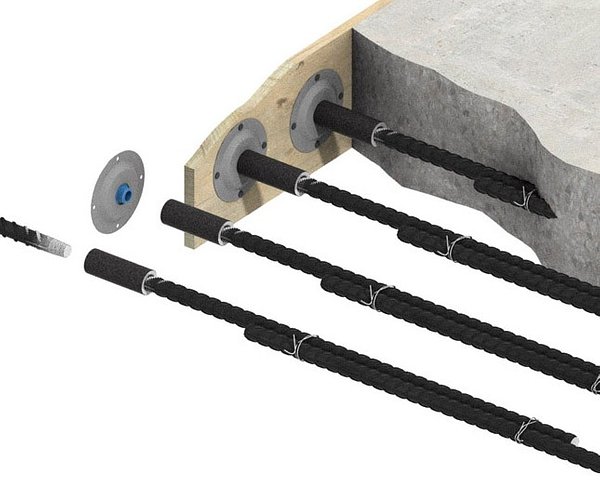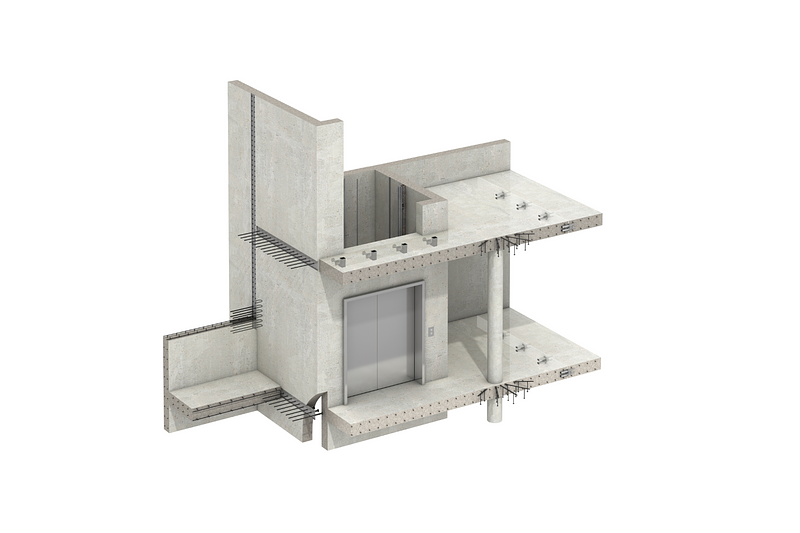Reinforcement Continuity Systems for Modern Construction
Concrete construction techniques continue to evolve in response to demands for safer, faster, and more efficient site operations. Among the key areas of development is the method of connecting structural elements, particularly in reinforced concrete construction. In recent years, the requirements of revised standards such as Eurocode 2 (BS EN 1992:1-1:2023) have increased the lap lengths for reinforcing bars, bringing new challenges for engineers and contractors.
As a result, connection systems must now accommodate greater structural demands, tighter schedules, and more diverse installation conditions, both in-situ and off-site. Neil Loy, Commercial Manager (Rebar Splicing) at Leviat provides an overview of how reinforcement continuity systems and related technologies have adapted to these pressures.
Rebend Continuity Systems
Reinforcement continuity boxes, commonly referred to as rebend boxes or pull out bars, have been in use for more than three decades. Developed initially in continental Europe, these systems were designed to simplify construction joints by avoiding the need for projecting bars and the associated task of drilling through formwork.
A typical rebend box consists of pre-bent reinforcement enclosed within a metal casing and sealed with a removable lid. Once the first phase concrete is cast and formwork is removed, the box lid is taken off and the bars are straightened for connection to the second-phase reinforcement.
Recent improvements to reinforcement continuity boxes have focused on durability, safety, and ease of installation. Galvanised steel casings now offer enhanced protection against corrosion, while the use of ductile reinforcement grades such as B500B or B500C helps reduce the risk of bar breakage during straightening, particularly in colder conditions. In addition, heavy duty plasticised cardboard lids have been introduced as a safer and more manageable alternative to traditional steel lids, improving on-site handling.
However, these systems are generally limited to bar diameters of 10, 12 and 16mm, due to the mechanical constraints of pre-bending and straightening. They may also present difficulties on congested sites where access is restricted, and the geometry of the box limits the available lap length, an increasingly important factor under the new design standards.
Eazistrip Reinforcement Continuity Systems
Leviat’s Ancon Eazistrip system remains a well-established solution for providing reinforcement continuity at construction joints. It simplifies wall-to-slab and wall-to-wall connections without the need for projecting bars or extensive formwork modification.
.png)
While the structural engineer is responsible for the rebar design, the Ancon Eazistrip system acts as a containment method, housing the reinforcement for later use. There are constraints on stirrup width, pull out leg length, and spacing (centres) that must be observed, but manufacturer guidance and verification software are available to confirm feasibility to ensure CARES Approved code-compliant connections.
Coupler Boxes
A more recent development is the use of coupler boxes, which combine aspects of rebend and starter bar systems. These consist of prefabricated continuity boxes fitted with Leviat’s CARES Approved Ancon CXL reinforcing bar couplers and short lengths of rebar (usually ‘U’ or ‘L’ shaped) acting as female starter bars. This configuration allows the continuation bars to be connected later, using mechanical couplers rather than lap splices.

The coupler box format simplifies installation while allowing for increased bar diameters, closer bar centres, and reduced site work. CARES Approved couplers ensure compliance and performance. The bars are pre-fixed in the casing, which is then installed as a single unit, saving time compared to individual bar placement. Continuation bars in turn are not restricted in length like those in rebend systems.

In practical terms, these systems have been successfully used in both in-situ and precast concrete settings. For example, during the construction of a leading infrastructure mitigation tunnel, coupler boxes are being installed to form walkways in a specialist precast construction. The system allows faster installation without the restriction in length of the continuation bar usually seen with traditional rebend boxes.
To increase compatibility with established detailing preferences, Leviat has developed a version of the Coupler Box that uses ‘U’ bars (as well as a version with ‘L’ bars), offering similar dimensions to traditional Eazistrip boxes. This makes a Coupler Box both a viable alternative or a natural complement to the Eazistrip range, particularly where design constraints demand greater flexibility in bar size, longer lap lengths, closer centres or are restricted by layout, or access.
Starter Bar Systems
Starter bars typically involve a two-part threaded connection between a female bar (cast into the first phase) and a male bar (installed later).
.jpg)
The advantages of starter bars include flexibility with bar diameter and length, making them well suited to current design codes. However, the process of individually fixing female bars into the first phase reinforcement cage can be labour-intensive. Starter bars are available as a TA1-B conical (taper) thread or metric (parallel) thread which meets TA1-A performance criteria.
KSN Anchor System
Developed for use in high-density reinforcement conditions, Ancon KSN Anchors are a compact mechanical alternative to hooked or straightened bars. Each anchor contains an internally threaded sleeve that receives a continuation bar at a later construction stage.

These systems are cast into walls and allow for faster connection without on-site bar manipulation. Originally pioneered in Australia, the KSN system has since been adapted for use in Europe. It is compatible with Eurocode 2 requirements, is CARES Approved, and has been independently tested at Heriot-Watt University, which confirmed improved anchorage performance in moment connections.
Ancon KSN Anchors can be used in walls and slabs with a minimum thickness (or depth) of 175mm. Design flexibility is further increased when the anchorage is paired at the top of the slab with either Ancon Eazistrip, Ancon Coupler Box, or individual Ancon Starter bars at the bottom of the slab.
KSN Anchor Box
For simpler shear load and tie force applications (non-moment connections), Leviat has also developed the Ancon KSN Anchor Box. This consists of a single row of KSN Anchors housed in a steel casing, suitable for slab centreline placement. It has been independently verified by the University of Sheffield and offers a pre-engineered solution for pin-ended joints.
This system does not accommodate bending moments but is effective for wall-to-slab connections where space is limited and reinforcement congestion is a concern.
Optimum designs
In recent years, the range of available concrete connection systems has expanded to meet the growing structural, safety, and scheduling demands of modern construction. Whether through conventional continuity boxes, mechanical coupler-based systems, or compact anchorage technologies like KSN, Leviat has developed a variety of solutions to support both in-situ and off-site construction.
.png)
While each system has its advantages and constraints, the ability to mix and match based on specific project needs offers designers and contractors a level of flexibility not previously available. Leviat’s diverse range of continuity products, combined with tools for verification and support, allows engineers to design and build with confidence under today’s more stringent structural standards.
To find out more about specifying concrete connection systems, email reinforcement.uk@leviat.com or call 0114 275 5224
Latest News
Leviat Introduces A1-Rated Non-combustible Insulation Retaining Clip for High-Rise Projects
Leviat, global leader in engineered construction solutions, has launched the Ancon A1-ST1 insulation retaining clip, a new non-combustible, A1-rated solution specifically designed to fit the Ancon ST1 heavy duty wall tie widely used in high-rise buildings.
Leviat Sponsors Concrete Society Awards 2025
Leviat is delighted to announce its continued sponsorship of the popular Concrete Society Awards for 2025, taking place on Wednesday 12th November, at London’s Royal Lancaster Hotel.


0 comments
Please leave a comment using the form below